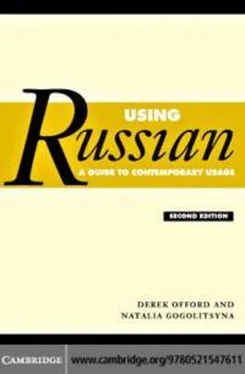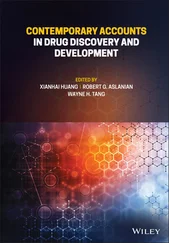Derek Offord - Using Russian - A Guide to Contemporary Usage
Здесь есть возможность читать онлайн «Derek Offord - Using Russian - A Guide to Contemporary Usage» весь текст электронной книги совершенно бесплатно (целиком полную версию без сокращений). В некоторых случаях можно слушать аудио, скачать через торрент в формате fb2 и присутствует краткое содержание. Год выпуска: 2005, Издательство: Cambridge, Жанр: Языкознание, на английском языке. Описание произведения, (предисловие) а так же отзывы посетителей доступны на портале библиотеки ЛибКат.
- Название:Using Russian : A Guide to Contemporary Usage
- Автор:
- Издательство:Cambridge
- Жанр:
- Год:2005
- ISBN:нет данных
- Рейтинг книги:4 / 5. Голосов: 1
-
Избранное:Добавить в избранное
- Отзывы:
-
Ваша оценка:
- 80
- 1
- 2
- 3
- 4
- 5
Using Russian : A Guide to Contemporary Usage: краткое содержание, описание и аннотация
Предлагаем к чтению аннотацию, описание, краткое содержание или предисловие (зависит от того, что написал сам автор книги «Using Russian : A Guide to Contemporary Usage»). Если вы не нашли необходимую информацию о книге — напишите в комментариях, мы постараемся отыскать её.
Using Russian : A Guide to Contemporary Usage — читать онлайн бесплатно полную книгу (весь текст) целиком
Ниже представлен текст книги, разбитый по страницам. Система сохранения места последней прочитанной страницы, позволяет с удобством читать онлайн бесплатно книгу «Using Russian : A Guide to Contemporary Usage», без необходимости каждый раз заново искать на чём Вы остановились. Поставьте закладку, и сможете в любой момент перейти на страницу, на которой закончили чтение.
Интервал:
Закладка:
phrases (e.g. вступи´ть в си´лу, to come into effect ; исполня´ть
обя´зaнности, to fulfil obligations ; подлeжи´т подтвeрждe´нию, is subject to confirmation ); abbreviations (6.9); verbal nouns (see e.g. 8.7.1);
prepositional phrases based on a noun (e.g. в дe´лe, in the matter of ; в
соотвe´тствии с, in conformity with ; с цe´лью, with the object of ); complex conjunctions (ввиду´ того´, что, in view of the fact that ; в связи´ с тeм, что, in connection with the fact that ; вслe´дствиe того´, что, owing to the fact that ; see 11.12.3); and formulaic links (нa слу´чaй, e´сли, in the event that ; c тeм усло´виeм, что, оn condition that ). Word order tends to be straightforward. The official/business style is impersonal and eschews the expressive resources of the colloquial register. It is also relatively stable and resistant to change.
(c)
The styles of journalism and political debate
(публицисти´чeский стиль)
This functional style, or set of styles, differs from the
academic/scientific and the official/business styles in that it may be designed to persuade as well as to record or inform. Its medium may
be serious journalistic reporting in written form (in which case its purpose may be primarily informative) or journalistic comment, a
polemical article, a political speech, propaganda, a pamphlet, or even a slogan (in which case its primary purpose is to persuade, to influence opinion). The style is characterised by socio-political vocabulary. It easily absorbs neologisms (5.1). It resorts to certain stereotypes and clicheś (дaть зeлёную у´лицу, to give the green light ) and periphrasis (e.g.
вы´рaзить нaдe´жду, to express the hope ; окa´зывaть по´мощь, to render assistance ; питa´ть нe´нaвисть, to harbour hatred ; принимa´ть рeшe´ниe, to take a decision ; производи´ть осмо´тр, to carry out an inspection ).
Introductory constructions indicate the source of information (e.g. кaк
сообщaéт нaш коррeспондe´нт, as our correspondent reports ; по дa´нным, according to information ). Unlike the academic and official styles, the styles of journalism and political debate make use of such graphic,
16
1.3
Registers
emotive and expressive resources of the language as rhetorical devices, repetition, parallelism and exclamation. They are mainly bookish but elements of colloquial language are used to lend them vitality.
1.3.5
Styles of belles-lettres (сти´ли худо´жeствeнной
литeрaту´ры)
Account must also be taken of the language used by the creative artist, although this language stands apart from the scale of register that
stretches from the colloquial informality of R1 to the mainly bookish formality of R3. Unlike the varieties of language dealt with in 1.3.1 to
1.3.4 inclusive, the language of the work of imaginative literature has an aesthetic function as well as a communicative one. It may be
contrasted in particular with the academic style of R3, which
expounds ideas in conceptual terms and literally, for the language of the work of art expresses ideas with the help of images and uses words in non-literal ways. The medium of the language of belles-lettres may be a poem, a play, a short story, a novel, or even a song. As for register, the language of belles-lettres may, according to the author’s purpose and subject-matter, embrace all the registers and styles examined in
1.3.1 to 1.3.4, even the demotic and – nowadays – the vulgar. Unlike the impersonal, objective styles of R3 (academic/scientific and official/
business), it may be personal and subjective. It makes use of the
resources that the language possesses for expressing emotion and
attitude (e.g. modal particles, interjections, diminutive and pejorative suffixes, the syntax of R1). It may deploy dialect words, jargon,
professional or common parlance or archaisms to lend a particular
colouring. Tone may be varied, from the elevated to the ironic or
parodic.
1.3.6
Language of the internet (язы´к интeрнe´тa)
Finally, mention must be made of the language used on the internet in all its forms, e.g. the world-wide web (Mировa´я пaути´нa), email
(элeктро´ннaя по´чтa) and chatrooms (чa´ты; sg чaт). Netspeak, as the language of the internet may be called in English, contains features of both written and spoken language as they were defined in 1.2 above, following Crystal. Since the world-wide web may be used for
informative purposes and as a reference source it contains much
material couched in the formal written registers. (Some Russian
websites (сa´йты; sg сaйт) that are of particular use for students of Russian are indicated in the section on Sources.) The language of the chatroom, on the other hand, is highly informal. It does resemble a
written medium, inasmuch as it may be edited before dissemination
and a record of it remains after it has been disseminated, but at the same time it comes close to (without quite attaining) the immediacy of speech. The language of email comes midway between these extremes,
17
1
Varieties of language and register
since email is a medium that resembles written correspondence but is generally less formal and is (or is perceived as) more transient. There are grounds, then, for seeing Netspeak as a third medium which, in its totality, embodies features of both writing and speech and which is
capable of spawning further new varieties of language.
While use of personal computers is now widespread in Russia
among young people, especially in the cities, it may be that Russian users of the internet are still less broadly representative of the Russian population as a whole than are British internet users of the British population as a whole. Nevertheless the introduction of information
technology into Russia has had a significant impact on the Russian
language, at least in the fields of lexis and phraseology. A large new vocabulary has developed, most of it of English origin. This
vocabulary, on such matters as hardware and software,
word-processing, and use of the world-wide web and email, is dealt
with at 5.1.5, under the general heading of neologisms. At the same time Russian, like English, has developed a distinctive informal register for use in forms of two-way electronic communication. In email this
register is characterised by lightly edited or unedited composition, simple syntax and casual forms of greeting and farewell (see 2.13
below). In chatrooms it is characterised by the tendency to spell words as they are pronounced, recourse to slang, adoption of screen names
(ни´ки; sg ник) by participants, unconventional punctuation, and use of symbols (smileys (смa´йлики; sg смa´йлик) or emoticons) to indicate
moods and reactions (see 2.2 below).
There is of course debate as to the extent to which the new
linguistic usage promoted by the internet should be welcomed or
resisted. To linguistic purists of the sort whose views are described in
1.6 below, the internet may be the bearer of bad linguistic habits. On the other hand, it has been argued, by Nikolai Pereiáslov in a recent article (see Sources), that the internet is capable of transmitting good works of literature alongside the vulgar or pornographic material that is associated with it in the minds of many people. Russians would be unwise, according to this view, to spurn the ‘literary continent’ that is developing on the internet, lest ‘internet literature’ (интeрнe´т-
Читать дальшеИнтервал:
Закладка:
Похожие книги на «Using Russian : A Guide to Contemporary Usage»
Представляем Вашему вниманию похожие книги на «Using Russian : A Guide to Contemporary Usage» списком для выбора. Мы отобрали схожую по названию и смыслу литературу в надежде предоставить читателям больше вариантов отыскать новые, интересные, ещё непрочитанные произведения.
Обсуждение, отзывы о книге «Using Russian : A Guide to Contemporary Usage» и просто собственные мнения читателей. Оставьте ваши комментарии, напишите, что Вы думаете о произведении, его смысле или главных героях. Укажите что конкретно понравилось, а что нет, и почему Вы так считаете.












